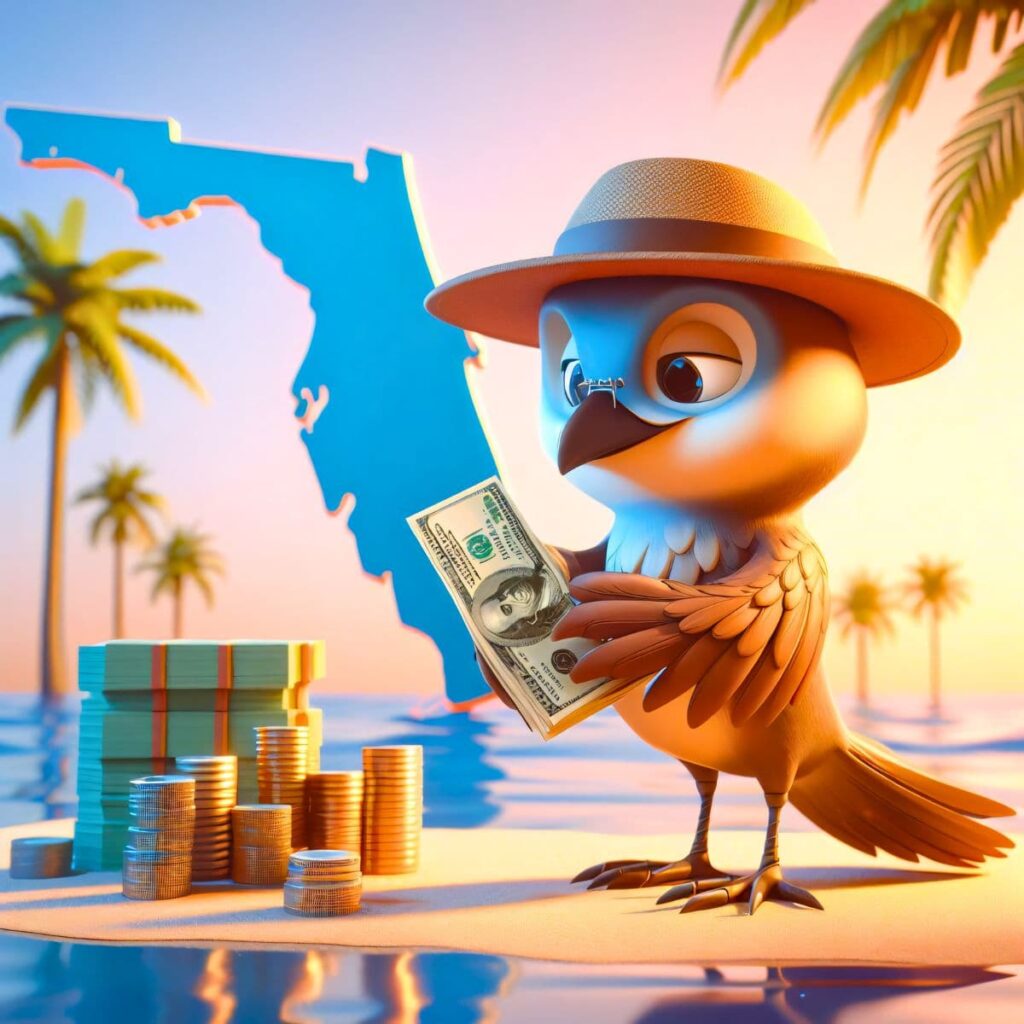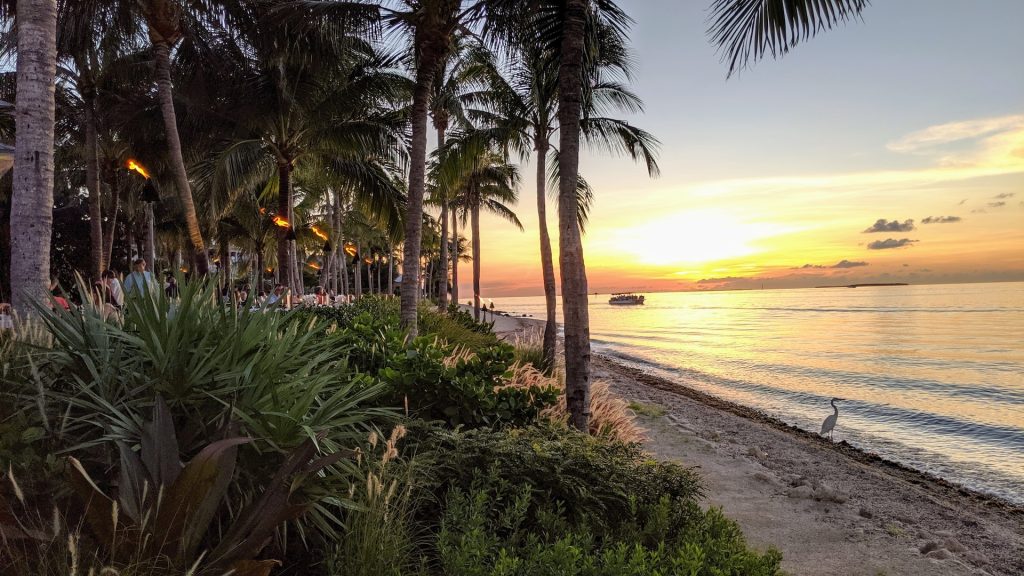So, you’re thinking of becoming a snowbird. But, how much does it cost to snowbird in Florida? Well, the short answer is, it can vary widely.
See, it’s a bit like asking how much a car costs. There’s a world of difference between a clunker and a high-end sports car. The same goes for snowbirding! It can be as frugal or luxurious as you want, but generally, you’re still looking at a chunk of change.
The biggest factors affecting your cost will be your accommodation and how many months you plan to stay down South. You’ll also need to factor in the food, fun, and fuel, plus all the pesky day-to-day expenses you can’t avoid.
Adequate planning can help you trim the fat off these costs and make this lifestyle much more affordable. In fact, I’ve got a whole guide on how to be a snowbird on a budget to help with that!

A Rough Estimate of the Cost of the Snowbird Lifestyle
As a rough estimate, your snowbird stay in Florida can cost you $4,000 per month, or $12,000 for three months. Of course, this is assuming you’re being on the frugal side and sticking to your budget.
Costs you will encounter are largely variable, but the major chunk goes to housing—that is, monthly rentals in Florida if you’re not eager to own a place, or your mortgage payment if you do. Even if you own a second home outright, there’s still taxes, utilities, and upkeep to contend with.
You’ll also need to factor in day-to-day expenses, which, depending where your home base is, could be more (though it also could be less) than other states.
On the higher end of the spectrum, snowbirding can cost you more than $21,000 per season! It all depends on your lifestyle, your rental, insurance, club memberships, groceries, transportation, and other costs.
So, at the end of the day, it’s hard to give a set figure. However, I will give you a rundown of how everything will affect your budget, so you can get a better understanding of what your costs for your specific situation look like.
Largest Components of Your Snowbird Budget
Let’s take a more in depth look at the biggest component of you snowbird budget, which is housing. Think of it as a pie—the bigger the slice for housing, the less there’s left for sundries like groceries or sightseeing.
Here are some ideas on how to trim the budget as it relates to housing:
- Length of Stay. Just remember that every month you stay is another month of rent, utilities, and other upkeep to pay for! Your stay could be as short as a month, or as long as 6 months for a typical snowbird (though not to exceed 183, per Florida residency requirements). Adjust your length of stay for your particular budget
- Start Saving Early. Especially if you’re still actively working, start setting aside a small portion of your paycheck every time. Let it sit in an interest bearing account of some type, and don’t even think about it during the rest of the year. By the time you’re ready to head South, you’ll have a nice cushion saved up!
- Consider Renting Your Primary Home. There are of course pros and cons to renting your home out, especially while you’re out of the area. However, renting your primary residence while you’re not there for the winter can be a great way to help offset the expenses of your snowbird home. If you have family or trusted friends or neighbors to check in, this makes it a lot easier!
- Alternative Housing Options. Think outside the box for your snowbird accommodations based on what works for you. Do you really need to rent a whole house? Would a smaller condo or even an apartment work? How about an RV? There are lots of other options besides a whole house, and the more you downsize, the more often you can save!
Consider Transportation
It’s also important to consider transportation as it relates to snowbirding. I’m not just talking about getting to Florida, but also what you’re going to do while you’re there.
For example, if you fly South, you’ll get there quickly and easily. If you book in advance, you can probably get the flights for around $300 per person (though it of course varies by airline, start and destination airports, time of year, etc).
However, once you arrive, you may need a rental car to get around, unless you have access to great public transportation, or want to rack up those Uber charges.
Rental cars certainly exist, but they aren’t cheap, especially for long periods. A “good deal” for a monthly rental is around $800 a month, and that’s not just some pocket change!
By the time you factor in the flight costs for 2 people and the rental car, you’re at close to $1,400 in transportation for just 1 month (and that’s not counting the return home).
So, think long and hard about your budget on transportation. Driving yourself down, while it takes longer, might be much more affordable.
Why Timing and Length of Your Stay Affect Your Budget
Here’s the thing about the timing and length of the snowbird season. It isn’t just about the fun in the sun; it’s also about money, and how you can balance the two. After all, we all care about our hard-earned cash! How long you stay can make a sizable difference to your budget.
As I mentioned earlier, some folks set up a savings account just for the snowbird season. Just get a little bit of your paycheck directly deposited into this account, and you’ll have a nice balance before you know it.
The more time and effort you spend planning, the more enjoyable and affordable your snowbird trip will be! That’s because you won’t be worrying about money and what you can and can’t (or should and shouldn’t) be doing every step of the way.
My favorite way to go about it is to first decide how long you want to stay ideally. Create a budget sheet for yourself with your average food, utilities, activities, transportation, and rent costs for that time period. Now, break it down over the number of paychecks you get every year.
Does that number work for you and your needs? Can you live on what’s left after that money is set aside? Great! Then you’re ready to set things up and start planning. If the answer is ‘no’, then it’s time to consider shortening your stay, changing your location or rental, or something else to trim the budget down.
Choosing an Economical Location in Florida
We all know Florida isn’t just one big beach. From the Gulf Coast to South Florida, there’s a bagful of spots to choose from. Your location matters when you’re looking to rent in Florida, as some are far more economical than others.
Sure, you can find affordable places, but if you’re aiming for Florida vacation rentals under $3,000 a month, your options might be a little slim.
Tampa and Fort Myers are on the Gulf Coast, where you can find lots of monthly rentals. Remember to cater not only to your budget but also keep near things you want to do, and transportation if needed (Tampa has an airport right there)!
You can find seasonal bungalows in Fort Myers for around $13,000. However, if you’re wanting something less quaint and more in the “super luxurious” category, then I’ve seen luxury condos with ocean views and pools going for as much as $76,000!
Location, size and type of rental, and of course length of stay as I’ve mentioned before play a huge factor into how much it costs to snowbird in Florida.
Investigating Housing Options as a Snowbird
Florida’s got a reputation for being fairly affordable as a vacation spot, but let’s be honest. When it comes to actually living there, it isn’t always one of the most affordable states, especially compared to some of its Northern counterparts.
As I’ve mentioned before, the major expense is housing, and monthly rentals in Florida can be slightly higher (largely due to the huge demand). So, when looking at your snowbird budget, remember that housing isn’t something you can overlook. It’s a big expense, so plan well and choose wisely.
Let’s break your housing options as a snowbird down a little more in depth.
Weighing Up Renting vs Owning
When you’re looking at snowbird housing options, you have to weigh up renting vs owning. There is no one-size-fits-all answer to this question. If you plan on soaking up the sun down South every year, you might consider buying a place. Why? Let me break it down.
Let’s say you’re staying for three months as a snowbird every year. Renting could cost you up to $9,000 (or more) for just that period. But if you buy, that $9,000 could cover a mortgage of $750 per month the entire year.
While it varies based on interest rates and down payment, that’s around a $150,000 house, condo, or apartment. Plus, then it’s yours so you have some equity. Not to mention, you then have the freedom to pop down anytime you want!
You could do a few seasons of renting as you scope out areas and types of places to live before you make the jump. However, if this is something you want to do year after year, it just makes sense to buy yourself a little piece of Florida paradise!

The Financial Implications of Renting Out Your Vacation Property
If you do own a vacation property in the Southern states, you can also consider renting it out for some extra dough when you’re not using it. Setting up is a breeze with all the vacation rental websites out there! You might even sleep better at night knowing that your property isn’t sitting vacant.
But remember, every coin has two sides. You might have to deal with some wear and tear, and the unforeseen costs of occasional maintenance can add up. However, if played right, this move offers a sweet combo of financial smartness and peace of mind.
Home vs Travel: The Financial Benefits of Renting Out Your House
Speaking of renting out your vacation home, what about the other way around? Renting out your house while you’re basking in Florida’s sun might sound like a hassle. But let’s get real: it can be a brilliant way to offset your travel costs.
Offering up your Northern primary residence to renters while you’re snowbirding in Florida brings in some cash. While you’re soaking in the sun, someone else could be caring for your house back home (and paying you for it)!
It’s like having a free house-sitter who also pads your wallet. So, why not give it a whirl? Your travels won’t last forever, but the financial gains sure will help them stick around longer.
Housing Alternatives to Cut Costs
As should be pretty clear by now, the biggest hurdle when becoming a snowbird is housing. If a huge house or a luxury condo isn’t in the budget, don’t fret!
I’ll walk you through some of the housing alternatives you can consider to cut costs.
Exploring the Potential of Downsizing
If you’re suddenly spending less time at your primary residence, consider downsizing and/or moving. Ditch the city for the suburbs, or switch from a huge house to a low maintenance condo or a quaint cottage.
Now, there are a few things to consider before you plunge in headfirst. You’ll want to consider how far away it is from your friends and family and the city’s amenities, like shopping or your workplace.
However, if it’s the right move for you at this time in your life, it might be just the ticket to free up some funds for your Florida getaway without tying all your money up in bricks and mortar.
RVs as Homes
Just because your home can (literally) go on the road doesn’t mean it’s not also your home! RVs are a great choice for those who want some freedom along with cutting costs.
While prices of RVs can vary widely based on size, features, whether you purchase new or used, and more, they are still cheaper than brick and mortar homes. Use an RV calculator to break it down for your specifics. However, as an example, a $50,000 RV at 3.5% interest over 10 years is only about $500 a month.
The average cost of a month at an RV campground ranges from $500 to $1,000 per month based on location and amenities, but utilities are very often included.
I’d challenge you to find a traditional monthly rental in Florida for $1,000 that’s got all utilities included! Plus, your RV is also your transportation, so that’s taken care of as well. You can even move to different cities, states, and campgrounds when you want a change of scenery!
Frequently Asked Questions
What is the Cheapest State For Snowbirds?
Georgia is one of the cheapest states for snowbirds. The state has a lower cost of living which makes it a more affordable option, especially compared to states like Florida.
Housing in Georgia is around 20% less expensive than in the rest of the country.
How Much Does It Cost to Snowbird in Florida?
On average, snowbirds can expect to spend anywhere from $5,000 dollars to $20,000 dollars for a winter season.
The cost of snowbirding in Florida varies depending on factors such as location, length of stay, accommodation type, lifestyle preferences, and individual spending habits.
What Are Some Major Expenses Associated with Snowbirding in Florida?
Major expenses associated with snowbirding in Florida include accommodation rental or ownership costs, utilities, and transportation (including gas, vehicle maintenance, and airfare).
While slightly less major, there are also healthcare expenses, food and dining out, entertainment, and recreational activities to consider.
How Can Snowbirds Save Money While Living in Florida?
Snowbirds can save money while living in Florida by budgeting and planning their expenses carefully, seeking out affordable accommodation options, and booking early.
They can also cook meals at home, use public transportation, and participate in free or low-cost activities.
Are There Different Cost Considerations for Snowbirds Renting vs. Owning Property in Florida?
Yes, snowbirds renting property in Florida may have lower upfront costs compared to those owning property, as they are not responsible for property taxes, homeowners insurance, and maintenance expenses.
However, rental rates may vary depending on location and amenities. Over time, the equity built in owning a home may outweigh the costs of renting annually.
How Does the Cost of Living in Florida Compare to Other Snowbird Destinations?
The cost of living in Florida varies depending on the region and lifestyle choices but is generally comparable to other popular snowbird destinations in the United States.
Factors such as housing, healthcare, and dining out may influence overall cost comparisons.
What Are Some Tips for Budgeting and Planning for Snowbird Expenses in Florida?
Tips for budgeting and planning for snowbird expenses in Florida include creating a detailed budget, researching accommodation and transportation options, estimating healthcare costs, setting aside funds for emergencies, and tracking expenses throughout the winter season.
Make sure to also book early on accommodations and transportation to save money. Set aside money monthly throughout the year for a savvy way to save up for your seasonal living.
Wrapping Up
I hope you now have a better idea of how much it costs to snowbird in Florida. If you’ve been dreaming of sandy beaches over shoveling snow in the winter, now you can better understand and start planning for your home away from home.
The biggest piece of the puzzle is of course your accommodations. Whether you’re renting or buying, choose a location and type of accommodation that’s going to suit your lifestyle and budget. Once you establish that, I find that the rest of it falls into place pretty easily.
While there are both pros and cons, you can also consider renting out the residence you’re not currently using to earn a little income which helps to offset the costs of being somewhere else for a good chunk of the year.
Happy traveling!
- Best Seafood Restaurants in Myrtle Beach South Carolina - July 17, 2024
- 20+ Fun Things to Do in Tempe Arizona: A Complete Guide - July 5, 2024
- Discover the Best Restaurants in Beaufort South Carolina - June 19, 2024




